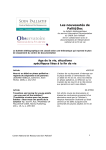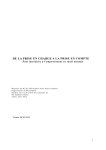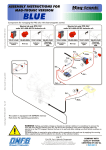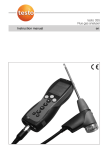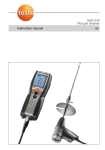Download MGS – Murco Gas Sensor Check / Calibration
Transcript
MGS – Murco Gas Sensor Check / Calibration Procedure* Content Page 1- Introduction 2 2- Bump Test 2 3- Calibration 3 4- Additional recommendations 3 5- Normalisation 3 6- Sample Test Certificate for System Log 4 *Technician use only These units must be checked / tested and /or calibrated by a suitably qualified technician who must test or calibrate the unit in accordance with the instructions as provided or set out in the relevant manual and the standards set down in their particular industry/country. Suitably qualified operators of the unit should be aware of the regulations and standards set down by their industry/country for the testing or calibration of this unit. These notes are only intended as a guide and insofar as permitted by law the manufacturer accepts no responsibility for the Calibration and Testing or operation of this unit. Failure to test or calibrate the unit in accordance with the then applicable instructions and with industry guidelines may result in serious injury including death and the manufacturer is not liable for any loss injury or damage arising from improper testing or calibration or inappropriate use of the unit. The testing or calibration of the unit must be carried out by a suitably qualified technician, in accordance with the testing or calibration manual and in compliance with locally applicable guidelines and regulations. 10 ASH (1) Murco Ltd. 114a Georges Street Lower, Dun Laoghaire Co Dublin. Ireland, e-mail: [email protected] web: www.murcogasdetection.com 1 1 - I N T RO DUC T I ON 2- B UM P T E S T (e ver y year ) The frequency and nature of testing or calibration may be determined by local regulation or standards. Ideally bump tests are conducted on site in a clean air atmosphere. EN378 and the FGAS Regulation require an annual check in accordance with the manufacturer’s recommendation. Prior to carrying out a bump test, check and adjust the zero setting as described in the Calibration section page 3 Sensor PCB 1.1 and 2.2. Murco recommends annual checks by bump test, and gas calibration on site at two yearly intervals in the case of semiconductor SC sensors and infrared IR sensors with sensor replacement every five years or as required. In the case of electrochemical EC sensors we recommend annual bump test and sensor replacement at two yearly intervals and gas calibration. This should eliminate end of life concerns, and constantly renew the detection system. If the MGS is exposed to a large leak it should be tested to ensure correct functionality by electrically resetting the zero setting and carrying out a bump test, see procedures below. 2.1 Semiconductor and IR sensors for hydrocarbons: We offer cylinders of gas at known concentrations for quantified tests. This consists of exposing the sensor to the gas and checking that alarm lights and relays are activated. If this is not available, for a non-quantified test you can use a gas cigarette lighter. By cracking open the valve without igniting the gas, you release the gas onto the sensor and force it into alarm. Check that alarm light, sounder and relay are activated. There are two concepts that need to be differentiated: bump test and calibration Bump Test: This consists of exposing the sensor to a gas and observing its response to the gas. The objective is to establish if the sensor is reacting to the gas and all the sensor outputs are working correctly. There are two types of bump test. Calibration Kit Flow Regulator Typical Flow 0.3L/Min Outlet 5/8’’ 18 UNF (C10) Flexible nonabsorbant tubing Vented Calibration Hood Cylinder 360mm high x 88mm diameter 440mm high with flow regulator 110L capacity of calibration gas Weight 1.4 kg Quantified: where a known concentration of gas is used, or Non-Quantified: where a gas of unknown concentration is used. Calibration: This consists of exposing the sensor to a calibration gas, setting the “zero” or “Standby voltage”, the span / range, and checking/adjusting all the outputs, to ensure that they are activated at the specified gas concentration. Procedures for bump test and calibration vary depending on the sensor technology used and the gas in question. The MGS is available in three sensor versions: Semiconductor (S S C), and Electrochemical (EE C) an d in f rar ed (I R ). Before you carry out the test or calibration: 1- Advise occupants, plant operators, and supervisors. 2- Check if the MGS is connected to external systems such as sprinkler systems, plant shut down, external sirens and beacons, ventilation, etc. and disconnect as instructed by the customer. 3- Deactivate alarm delays if selected at JP5, JP6 as per instructions in Diagram 1. 4- For Bump Test or Calibration the MGS should be powered up overnight. If the unit has been installed and running for about 24 hrs, and you need to power it off for a short time to set the delay at 0 min, then the normalisation period is about 5 min (this is indicated by the green LED flashing) and then you can begin the testing or calibration. If sensors have been in long-term storage or the detectors have been turned off for a long time, normalisation would be much slower. However within 1-2 hours the sensor should have dropped below the alarm setting and be operational. You can monitor normalisation progress exactly by monitoring the sensor output, on CON 2 between pins OV & VS. See Section 5. 2.2 Electrochemical sensors: We offer Ampoules of ammonia (NH3) at 100ppm and 1.000 ppm. Cylinders of calibration gas are also available. These are a quantified test. For details of other Ampoules, please contact us. 2.3 Infrared sensor for CO2: We offer Ampoules of CO2 at 5000 ppm. Cylinders of calibration gas are also available. These are a quantified test. If these are not available, then you can breathe on the sensor. Human breath has enough CO2 to trigger the alarm. This is a non-quantified test. 2.4 Bump test using gas ampoules: 1- Make sure that both the ampoules and the calibration beaker are clean and dry. 2- Unscrew the beaker hold screw and place the ampoule so that is sits in the base of the beaker. As per illustration. Di a g r a m 1 Zero Span SW2 P3 3- Tighten on the screw ampoule without breaking it. SW1 P2 Relay + Sounder P1 4- Remove the enclosure lid of the gas detector (not in Ex area). LD2 LD1 JP6 6 5 4 3 2 1 JP1 CN1 CN2 CN3 Relay & Sounder Delay – JP5 & JP6 off : no delay JP5 on only : 1 Minute JP6 on only : 5 Minutes JP5 & JP6 on : 10 Minutes JP3 – on : 4-20mA or 2-10Volt output off : 0-10Volt or 0-5 Volt output JP2 – on : Sounder enabled JP1 – on : 0-5Volt output off : 0-10Volt output NC COM NO I V 0V iv 0V A D 2 5- Connect voltmeter to monitor sensor response, monitor 010v (Jumper JP1 and JP3 off) response on CON 2 between pins OV & V. 6- Place the beaker over the sensor head using the multi sensor adaptor to fit the sensor, or, if an Exd, IP66 or Remote sensor head version, screw the beaker on the remote sensor head M42 thread, or M35 thread adaptor. It should be as tight fitting as possible to allow maximum exposure to the gas. 7- Tighten on the ampoule until it shatters allowing the contents to diffuse in the beaker. It should be left in place for approximately 5 min. Electrochemical or IR Sensor SW2 D iagr am 3 SW1 Short to Cancel Warm up Delay 8- Voltage output will increase. This confirms that the sensor is responding. In the case of an ampoule quantified test a response equivalent to at least 50% of the test gas will confirm that the system is in order. Sounder & Relay Set Point Voltage (Ref 1) Adjust Span (Adjust zero in IR model) 0V Adjust Zero (Adjust span in IR model) 9- Carefully remove any ampoule remains from the gas detector and beaker. Sensor Voltage (VS) 6 5 4 3 2 1 Adjust Sounder and Relay set point (P1) 2 . 5 Bu m p Te st U sin g Gas C ylin d er s. Remove the enclosure lid of the gas detector (not in an Ex area). Connect voltmeter to monitor sensor response, monitor 0-10V (Jumper JP1 and JP3 off) response on CON 2 between pins OV & V. Expose the sensor to gas from the cylinder. You can place the entire MGS into a plastic bag or use a plastic hose/hood to direct gas to the sensor head. A response of above 80% is acceptable. CN1 CN2 Relay and Sounder Delay – JP5 & JP6 off : no delay JP5 on only : 1 minute JP6 on only : 5 minutes JP5 & JP6 on : 10 minutes JP4 – on : Not used JP3 – on : 4-20mA or 2-10 Volt output off : 0-10Volt output JP2 – on : Sounder enabled JP1 – on : Divide Voltage output by 2 (0-5 or 1-5 Volt output off : full 0-10 or 2-10 volt output AC DC CN3 A D Power 12 to 24V DC 12 to 24V AC Jumper for AC or DC Relay Output 4-20mA output 0-5/1-5/0-10/2-10 Volt output 0V A D 3 - C A L I BR AT IO N 2- Electrochemical Sensor (EC) This is the adjustment of the gas detector’s accuracy or recalibrating after sensor element exchange using calibration gas. There are two adjustments required: the zero and the span. They are monitored at 0V and VS on a 0-5V scale. If the target range is 0-1000ppm, and the gas used is 1000 ppm then 5V=1000ppm. Murco offers a calibration kit that consists of a Calibration gas cylinder, a flow regulation valve with flexible non-absorbant tubing and vented calibration hood. 3- Infrared (IR) (see Diagram 3) Tools required: 1- Gas can with the appropriate gas and concentration 2- A voltmeter- crocodile clips recommended 3- Estimate 30 min per sensor 3.1- Pot VR202 is used to adjust the zero of the range (span). Monitor the output between 0V (negative) and VS (positive) and expose the sensor to Nitrogen or zero air, and once stable, adjust the Pot to 0 V or slightly positive (0.01 V is acceptable). The MGS has three sensor PCB versions: SC, EC, IR. 3.2- Pot VR201 is used to calibrate the range (span) of the sensor. Monitor the output between 0V (negative) and VS (positive). Expose the sensor to calibration gas and allow to stabilise and adjust pot VR202 to 5V. Calibration and alarm relay set point is done on a 0-5V scale. NOTE: Sensors outputs are linear, thus as long as you have a gas canister of known concentration you can calibrate to any desired range. Adjusting the alarm relay This process is the same for all versions. See diagram 2 and 3 for location of pot P1 and test points 0V and REF1. Example: For a range of 0-1000ppm, and a canister of the target gas at The first step to setting the alarm relay at the desired levels: 800ppm The 0-5V signal corresponds to 0-1000, thus if using the above canister: Voltage= 800 ppm x 5 = 4V and so the output voltage signal should 1000 be adjusted to 4V. 1- Pot P1 is used to adjust the set point at which the relay activates. Monitor the output between test points 0V (negative) and REF1 (positive). See example below. Example: For a range of 0-1000ppm, relay @ 100ppm Relay = 100 ppm x 5 so that Alarm relay = 0.5 Volts 1000 while the 0-5V output sensor signal corresponds to 0-1000 ppm range. 4- A DD IT I ON A L R E CO M ME N DAT I ON S FAL S E AL A RM S: If false alarms are being triggered by background gases, paint fumes, etc, extreme humidity or temperature conditions, you will find that the zero has moved to a + value, you can adjust the zero setting back to zero to compensate. You may also increase the response time delay to help eliminate false alarms. Sensor PCB – adjusting the detection range 1- Semiconductor Sensor (SC) (see Diagram 2) 5. N o rm alisat io n P erio d There are two adjustments required: the zero and the span. They are monitored at 0V and VS on a 0-5V scale. If the target range is 0-1000ppm, and the gas used is 1000 ppm then D i a g ra m 2 5V=1000ppm. 1.1- Pot P2 is used to adjust the zero of the range (span). Monitor the output between 0V (negative) and VS (positive) and adjust the Pot to 0 V or slightly positive (0.01 V is acceptable). 0V REF1 Zero Span VS SW2 P3 Sensor Type Electro-Chemical Semi-Conductor Infrared SW1 P2 P1 Relay + Sounder LD2 LD1 If sensors have been in long-term storage or the detectors have been turned off for a long period, normalisation would be much slower. However within 12 hours sensors should have dropped below the alarm level and be operational. You can monitor progress exactly by monitoring the 0-10V output, when the output settles around zero the sensor is normalised. In exceptional circumstances the process can take up to 24hours or more to get to 0V, again monitor the 0-10V output and you can see what is happening. JP1 CN1 CN2 Stabilised ~0V 20-30 Seconds 1-3 Minute 2 Minute The electro-chemical sensor on power up outputs a signal voltage normally below the set alarm level. Semiconductors output over the + max scale i.e. > 5V. Both move towards zero as they stabilise. JP6 6 5 4 3 2 1 CN3 NC COM NO I V 0V iv 0V 2.2- Pot P3 is used to calibrate the range (span) of the sensor. Monitor the output between 0V (negative) and VS (positive). Expose the sensor to calibration gas and allow to stabilise and adjust pot P3 to 5V. Below we show typical time to normalize for various sensor types. The units are powered up and the output voltage monitored on the 0-10V-output. The approximate time to drop to near 0V is shown. A D 3 MGS Test Certificate (Example) (Download original from our web site www.murcogasdetection.com. Use in Conjunction with the Murco Check Calibration Procedure) Pr oduc t De s c rip tion: MGS Se r ia l Num be r: 12345 D a te of F ir s t Ca lib ra tion: (see Rating Label) 25/10/05 D a te of L as t Ca libr a tion: 25/10/05 Ty pe /R a nge of Te s t G as : Cylinder 1000ppm R404a, batch no xxxx 1. Carry out Bump Test (Set delay to zero) Power (Green LED) Visual Alarm (Red LED) Sounder Operating Relay Operating Remote Systems if connected to relay C h ec k A n a l o g u e O u t p u t i n U s e , e . g . 0 – 10V Sy s te m Pa s s e d If system failed, carry out a gas calibration. See below. 2. On site Gas Calibration (2 Yearly) Sy s te m Pa s s e d If the MGS did not respond correctly and could not be recalibrated due to age, exposure to gas etc, then either the MGS or the sensor element should be replaced (and recalibrated) and the test process repeated. Sy s te m Pa s s e d We hereby certify that the above specified test procedure has been performed and the MGS is performing as specified. Test Performed by Signature Date 4






